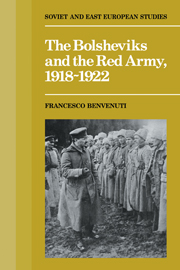Book contents
1 - The disintegration of the Imperial Army
Published online by Cambridge University Press: 03 October 2009
Summary
The process of democratization
The famous Prikaz no. 1, promulgated on 2 (15) March 1917 by the Petrograd Soviet, in response to pressure from the military units stationed in the city, was defined by Trotskii many years later as ‘the single worthy document of the February revolution’. This ‘charter of the freedom of the revolutionary army’ or ‘soldier's Bill of Rights’ embodied the demands made by the most radical elements of the revolutionary movement in the Imperial Army. The Order was also the clearest possible indication that the disintegration of the Russian armed forces had now gathered a momentum that it would be hard to contain. The democratic and libertarian spirit reflected in the text rendered any attempt to reconcile it with the maintenance of a fighting army, depleted and exasperated by a series of bloody defeats at the front, purely illusory. More than anything else, it had been Russia's increasing involvement in the World War, in human even more than in economic terms, that had prompted the units in the firing line to follow the initiative taken by the soldiers of the Petrograd garrison. With a total of approximately 9 million men in uniform – over a third of the able-bodied male population – the Russian troops had long since ceased to be merely the nation's fighting arm. They were in fact a very representative slice of the country as a whole. To sustain the war effort, it seemed that steps to militarize the rear would sooner or later become inevitable.
- Type
- Chapter
- Information
- The Bolsheviks and the Red Army 1918–1921 , pp. 5 - 19Publisher: Cambridge University PressPrint publication year: 1988



